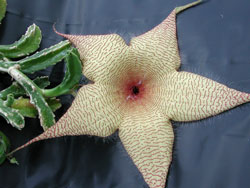Resource Library
Plant of the Week: Carrion Cactus
The University of Arkansas System Division of Agriculture does not promote, support or recommend plants featured in "Plant of the Week." Please consult your local Extension office for plants suitable for your region.
Plant of the Week
Carrion Cactus
Latin: Stapelia gigantea

Plants are great problem solvers. When a species is given a set of problems to solve, plants have a way of working through the difficulties and arriving at elegant solutions. An example of this problem-solving ability can be seen in the carrion cactus (Stapelia gigantea) that blooms in late summer and early fall.
The carrion cactus is not a true cactus but a member of the milkweed family from South Africa. It grows about 8 inches tall and spreads sideways by a series of succulent, coarsely toothed leafless stems. Depending on their age and degree of engorgement, the stems will be rounded, squarish or plus-shaped when viewed in cross section. They have no thorns but have been lumped in popular parlance with true cacti because they grow in dry, rocky ground like some of our American prickly pear cacti.
The star-shaped flowers look like a starfish in general outline and size. The base color of the flower is light tan to a brownish yellow with a series of reddish maroon, interrupted lines running perpendicular to the outstretched petals. At the center of the flower, these lines are closer together to give the plant a blood-colored central eye where the black stamen and pistil reside.
In a wonderful example of biological mimicry, the flowers not only have the general look of an open wound, but they also smell like ripe road kill. Flies, beetles and all manner of insects are carrion feeders, so from a problem solving standpoint the carrion cactus has simply used the resources around it to get what it needs.
Its stem architecture is also well-suited to surviving in low rainfall areas. It long ago gave up its leaves and committed its stems to the role of photosynthesis. To get through periods of drought, these stems are pleated in cross sections so they can contract in dry times and swell as they take on more water during the rainy periods.
At one time the Stapelia genus was large and included a whole series of plants with interesting and variable blooms and stem types. Over the years species have been separated out into separate genera based primarily on differences in flower characteristics. Orbea, Orbeopsis and Huernia have plants that have the overall look of Stapelia except for their flowers.
To have a carrion-smelling houseplant on your windowsill may be a bit off-putting to some, but the plants are an excellent example of nature’s ability to problem solve in a difficult environment. The odor need not be a serious problem because a cultivar called ‘Schwankart’ is available that is claimed to be odor-free. But really, why would anyone want to grow a carrion cactus that didn’t stink?
The Stapelia are easy to grow in small 4- to 6-inch pots. Use any well-drained potting soil. During the summer, move them to a sunny patio and let rainfall provide the needed watering. In the winter, give them a bright area but hold back on the water. Keep the wintertime temperature above 40 degrees. They will overwinter out of doors in north Texas. Mealybugs are the only serious insect pest.
By: Gerald Klingaman, retired
Extension Horticulturist - Ornamentals
Extension News - November 13, 2009
The University of Arkansas System Division of Agriculture does not maintain lists of retail outlets where these plants can be purchased. Please check your local nursery or other retail outlets to ask about the availability of these plants for your growing area.